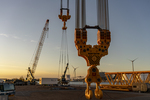New study explores what it would take for Hawaii to achieve a zero-carbon economy by 2045
A new study commissioned by Hawaiian Electric explores pathways to a net-zero carbon economy by 2045 and makes clear that major technological advances, especially in sustainable fuels and carbon-capture, and reaching consensus on land-use policy are some of what’s required for Hawaii to fully decarbonize over the next 22 years.
State law mandates a 50% reduction in greenhouse gas emissions by 2030 compared to 2005 levels and for Hawaii to be net-zero by 2045. With time running short to meet these targets, the new pathways study advises that aggressive actions will need to be underway by 2030 to create a glide path to full decarbonization that is less steep than if actions are delayed.
“This study is the first of its kind for Hawaii and we commissioned it to understand the scale of decarbonization required in every sector of our economy and the scope of work needed to be successful over the next two decades,” said Shelee Kimura, president and CEO of Hawaiian Electric.
“We want to ensure we deliver on our part in this interdependent effort for our state. Renewable energy is required but that alone doesn’t get Hawaii to the finish line. The study confirms that success requires contributions from every individual and every industry. We’ve made a lot of progress already by working together and we offer this report to policymakers, researchers, planners, businesses, organizations and individuals as a conversation starter and as a resource for creating action plans across all sectors of our economy.”
Using data collected from the five islands served by Hawaiian Electric, the analysis charts the sources of emissions tracked by the state’s greenhouse gas inventory, including electricity, aviation, vehicles, industry, buildings, agriculture and waste. Electricity generation accounts for 27% of emissions. Transportation generates 48% of emissions, including aviation, ground, marine and military uses, compared to 28% for the rest of the U.S., highlighting one of the unique challenges to decarbonizing the island economy.
The study finds that energy efficiency and reducing the demand for energy are “crucial” in achieving short- and medium-term emission reductions and reducing the amount of land that will be needed for future renewable energy projects.
Hawaiian Electric worked with Energy and Environmental Economics (E3), a nationally recognized consulting firm that has conducted similar studies for the California Energy Commission, the U.S. Climate Alliance and many utilities and government agencies. “Hawaii Pathways to Net Zero – an Initial Assessment of Decarbonization Scenarios” builds on Hawaiian Electric’s Climate Change Action Plan, which commits to reducing greenhouse gas emissions from its operations 70% by 2030 compared with 2005 levels.
The study isn’t intended to suggest approaches to achieving net zero but explores what might be needed in terms of energy infrastructure, technology adoption and supportive public policies.
In 2022, the Legislature tasked the State Energy Office with undertaking a similar study to “analyze pathways and develop recommendations for achieving the state’s economy-wide decarbonization goals.” Hawaiian Electric has provided its pathways study to the state and key policymakers as a potential resource to help inform the state’s work.
“Hawaiian Electric deserves credit for taking a holistic view of carbon impacts among all sectors in its Pathways to Net Zero study that can serve as a basis to inform future policies and actions,” said Mark Glick, the state’s Chief Energy Officer. “With the State Energy Office’s intention to also investigate energy costs, sectoral workforce impacts and recommendations for next steps, the back-to-back decarbonization analyses might be considered a one-two punch to counter the harmful effects of carbon-intensive energy in Hawaii.”
Hawaiian Electric commissioned the study to advance its Climate Change Action Plan. The study explores the utility’s role in decarbonizing the economy and how its targets align with actions in other sectors. Hawaiian Electric asked E3 to develop long-term, economywide decarbonization scenarios that would show how Hawaii’s 2045 target could be achieved.
Among the key findings of the pathways study that could drive action:
- Renewable electricity generation is necessary but not sufficient by itself to meet Hawaii’s decarbonization goals.
- The electrification of transportation and industry will significantly increase the amount of electricity that needs to be generated. Demand for power would at least double by 2045.
- Electrification is a key driver in decarbonization of ground transportation but in aviation and marine transportation decarbonized fuels will be required.
- Even with 70% electricity decarbonization and ambitious efforts in other sectors to achieve statutory greenhouse gas reduction targets, more aggressive near-term actions will likely be required to hit the state’s 2030 target of 50% GHG reductions.
- Carbon dioxide removal – also called carbon sequestration – will be required to achieve net zero, either through increased natural sinks or negative emissions technologies.
- Energy efficiency and conservation are crucial in supporting the net zero goal by reducing the amount of renewable electricity and fuels that must be procured.
“Hawaii Pathways to Net Zero – an Initial Assessment of Decarbonization Scenarios” is available at hawaiianelectric.com/decarbonization.
- Source:
- Hawaiian Electric
- Author:
- Press Office
- Link:
- www.hawaiianelectric.com/...
- Keywords:
- Hawaiian Electric, USA, energy transition, decarconization, industry, net zero, economy
























